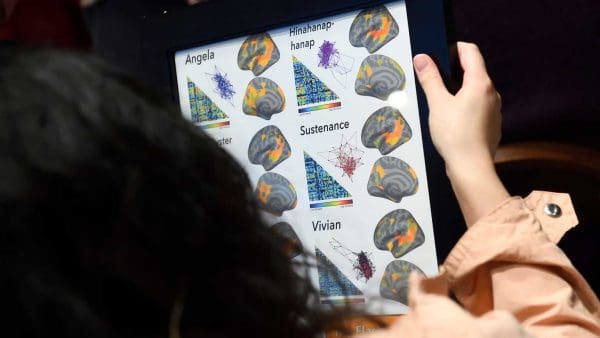Audrey Branch is trying to learn more about aging by studying old and young brains. Specifically, she’s interested in how cells connect to form memories and what might be going wrong with those connections when older people start to forget things.
Until recently, getting at that question meant months of tedious specimen preparation. And even then, the very prep that made getting a glimpse of the brain’s core possible—slicing what’s already tiny into thousands of pieces—likely destroyed the delicate connections the Johns Hopkins neuroscientist needed to see.
That changed last spring when a new, three-dimensional microscope arrived at the university’s Homewood campus, a cutting-edge tool that not only condenses what had been months of work into just hours, but allows university researchers unprecedented views of organs, tissue, and even live specimens.
Just practicing with it, Branch knew it was a game-changer. She cried when she saw the first pictures of a mouse brain, its individual neurons glowing red, and its spindly dendrites, too—showing quite clearly the links between those cells.
“It feels so amazing to see the brain in a way that no one has ever seen it before,” she says. “It’s pretty much the greatest thing I’ve ever experienced in science.”
The selective plane florescence light sheet microscope arrived on campus in April, one of the first in operation on the East Coast and the only one in Maryland. Purchased with a grant from the National Institutes of Health, it cost $360,000.
Unlike other microscopes, this one illuminates specimens from the side, shooting two perfectly aligned planes of light across an object, illuminating a wafer-thin slice of the whole while the camera captures the image—thousands of times over—as the specimen moves through the light. When the images are displayed together, the result is a three-dimensional image or video clip of the full object, sort of like the more familiar CAT scan.
The technology is very new, but Michael McCaffery, director of the university’s Integrated Imaging Center, expects researchers everywhere will be using it within a few years. Just among the Johns Hopkins community, word of the light sheet is already out, and scientists have been lining up to use it.
“People really want to use this,” says McCaffery, a research scientist in the Krieger School’s Department of Biology. “It fills a niche, that until now, was unavailable at Hopkins. Simply, there was no instrument that allowed a researcher to take a whole organ, brain, or cardiac muscle, and image them in three-dimensions, in their entirety.”
The light sheet is the latest advance in modern microscopy—a world that’s been evolving since fluorescence microscopy became the standard in the 1960s.
The new light sheet allows samples up to 12 to 15 millimeters, or about a half an inch. Researchers can study much larger samples, even entire organs. And because the samples don’t have to be cut up, researchers who are interested in how cells, ducts, or veins connect have a chance to observe them, unspoiled.
“It’s a very big deal for researchers, particularly those interested in the science of connectomics,” McCaffery says. “Mapping the neuronal connections of the brain is the holy grail of neurology.”




